BOOKS OF RELATED INTEREST BY SERGE LANG
Linear Algebra, Third Edition
1987, ISBN 96412-6
Undergraduate Algebra, Second Edition
1990, ISBN 97279-X
Complex Analysis, Third Edition
1993, ISBN 97886-0
Real and Functional Analysis, Third Edition
1993, ISBN 94001-4
Introduction to Algebraic and Abelian Functions, Second Edition
1982, ISBN 90710-6
Cyclotomic Fields I and II
1990, ISBN 96671-4
OTHER BOOKS BY LANG PUBLISHED BY
SPRINGER-VERLAG
Introduction to Arakelov Theory • Riemann-Roch Algebra (with William Fulton) •
Complex Multiplication • Introduction to Modular Forms • Modular Units (with Daniel
Kubert) • Fundamentals of Diophantine Geometry' Introdm:tion to Complex Hyper
bolic Spaces • Elliptic Functions • Number Theory III • Algebraic Number Theory •
SL2(R) • Abelian Varieties • Differential and Riemannian Manifolds • Undergraduate
Analysis • Elliptic Curves: Diophantine Analysis • Introduction to Linear Algebra •
Calculus of Several Variables • First Course in Calculus • Basic Mathematics •
Geometry: A High School Course (with Gene Murrow) • Math! Encounters with High
School Students • The Beauty of Doing Mathematics • THE FILE
�
Serge Lang
I
/Algebraic Number
Theory/
/
Second Edition
, I ' 1
;
:'"
.
.
\ . ,
!" >-
Springer
�
Serge Lang
Department of Mathematics
Yale University
N"ew Haven, CT 06520
USA
Editorial Board
S. Axler
D~partment of
Mathematics
F.W. Gehring
Department of
Mathematics
P.R. Halmos
Department of
Mathematics
Michigan State University
Eest Lansing, MI 48824
USA
University of Michigan
Ann Arbor, MI 48109
USA
Santa Clara University
Santa Clara, CA 95053
USA
Mathematics Subject Classifications (1991): 11Rxx, llSxx, llTxx
With 7 Illustrations
Library of Congress Cataloging-in-Publication Data
Lang, Serge, 1927-
j
Algebraic number theory! Serge Lang. - 2nd ed.
(Graduate texts in mathematics; 110)
em. -
p.
Includes bibliographical references and index.
ISBN 0-387-94225-4
1. Algebraic number theory.
1. Title.
'.
QA247.L29 1994
51Z'.74-dc20
II. Series.
93-506Z!fo'
Originally published in 1970 © by Addison-Wesley Publishing Company, Inc., Reading,
Massachusetts.
© 1894, 1986 by Springer-Verlag New York, Inc.
All rights reserved. This werk may not be translated or copied in whole or in part without
the ~Titten permission of the publisher (Springer-Verlag New York, Inc., 175 Fifth Avenue,
New York, NY 10010, USA), except for brief excerpts in connection with reviews or
scholarly analysis. Use in connection with any form of information storage and retrieval,
electronic adaptation, computer software, or by similar or dissimilar methodology now
known or hereafter developed is forbidden.
The use of general descriptive names, trade names, trademarks, etc., in this publication,
even if the former are not especially identified, is not to be taken as a sign that such names,
as understood by the Trade Marks and Merchandise Marks Act, may accordingly be used
freely by anyone.
Printed and bound by Edwards Brothers, Ann Arbor, MI.
Printed in the United States of America.
98765 432
ISBN 0-387-94225-4 Springer-Verlag New York Berlin Heidelberg
ISBN 3-540-94225-4 Springer-Verlag Berlin Heidelberg New York
�
Foreword
The present book gives an exposition of the classical basic algebraic
and analytic number theory and supersedes my Algebraic Numbers,
including much more material, e.g. the class field theory on which I make
further comments at the appropriate place later.
For different points of view, the reader is encouraged to read the collec
tion of papers from the Brighton Symposium (edited by Cassels-Frohlich),
the Artin-Tate notes on class field theory, Weil's book on Basic Number
Theory, Borevich-Shafarevich's Number Theory, and also older books like
It seems that
those of Weber, Hasse, Heeke, and Hilbert's Zahlbericht.
over the years, everything that has been done has proved useful, theo
retically or as examples, for the further development of the theory. Old,
and seemingly isolated special cases have continuously acquired renewed
significance, often after half a century or more.
The point of view taken here is principally global, and we deal with
. local fields only incidentally. For a more complete treatment of these,
cf. Serre's book Corps Locaux. There is much to be said for a direct global
approach to number fields. Stylistically, I have intermingled the ideal
and idelic approaches without prejudice for either.
I also include
two proofs of the functional equation for the zeta function, to acquaint
the reader with different techniques (in some sense equivalent, but in
another sense, suggestive of very different moods). Even though a reader
will prefer some techniques over alternative ones, it is important at least
that he should be aware of all the possibilities.
New York
June 1970
SERGE LAKG
v
�
Preface for the Second Edition
The principal change in this new edition is a complete rewriting of
Chapter XVII on the Explicit Formulas. Otherwise, I have made a
few additions, and a number of corrections. The need for them was
pointed out to me by several people, but I am especially indebted to
Keith Conrad for the list he provided for me as a result of a very careful
reading of the book.
New Haven, 1994
SERGE LANG
vi
�
Prerequisites
Chapters I through VII are self-contained, assuming only elementary
algebra, say at the level of Galois theory.
Some of the chapters on analytic number theory assume some analysis.
Chapter XIV assumes Fourier analysis on locally compact groups. Chap
ters XV through XVII assume only standard analytical facts (we even
prove some of them), except for one allusion to the Plancherel formula in
Chapter XVII.
In the course of the Brauer-Siegel theorem, we use the conductor
discriminant formula, for which we refer to Artin-Tate where a detailed
proof is given. At that point, the use of this theorem is highly technical,
and is due to the fact that one does not know that the zeros of the zeta
function don't occur in a small interval to the left of 1. If one knew this,
the proof would become only a page long, and the L-series would not be
needed at all. We give Siegel's original proof for that in Chapter XIII.
My Algebra gives more than enough background for the present book.
In fact, Algebra already contains a good part of the theory of integral
extensions, and valuation theory,
redone here in Chapters I and II.
Furthermore, Algebra also contains whatever will be needed of group
representation theory, used in a couple of isolated instances for applica
tions of the class field theory, or to the Brauer-Siegel theorem.
The word ring will always mean commutative ring without zero divisors
and with unit element (unless otherwise specified).
If K is a field,
then K* denotes its multiplicative group, and Kits
algebraic closure. Occasionally, a bar is also used to denote reduction
modulo a prime ideal.
We use the 0 and 0 notation. If j, g are two functions of a real variable,
and g is always ~ 0, we write j = O(g) if there exists a constant C > 0
such that Ij(x)I ~ Cg(x) for all sufficiently large x. We write j = o(g) if
lim",--->",j(x)jg(x) = O. We writej ~ g iflim",--->",j(x)jg(x) = 1.
vii
�
Contents
Part One
General Basic Theory
CHAPTER I
Algebraic Integers
-\.1.
2.
3.
4.
5.
6.
7.
8.
9.
.
Localization
Integral closure
Prime ideals
.
Chinese remainder theorem
Galois extensions
Dedekind rings
Discrete valuation rings
Explicit factorization of a prime
Projective modules over Dedekind rings
CHAPTER II
Completions
-!.. 1. Definitions and completions
Polynomials in complete fields
2.
3. Some filtrations
4. Unramified extensions
5. Tamely ramified extensions
.
CHAPTER III
The Different and Discriminant
1. Complementary modules
2. The different and ramification
3. The discriminant
ix
3
4
8
11
12
18
22
27
29
31
41
45
48
51
57
62
64
�
x
l. Roots of unity
2. Quadratic fields
3. Gauss sums
4. Relations in ideal classes
Cor,TENTS
CHAPTER IV
Cyclotomic Fields
CHAPTER V
Parallelotopes
l. The product formula
2. Lattice points in parallelotopes
3. A volume computation
4. Minkowski's constant
CHAPTER VI
The Ideal Function
l. Generalized ideal classes
2. Lattice points in homogeneously expanding domains
3. The number of ideals in a given class .
CHAPTER VII
Ideles and Adeles
'- l.
2.
~ 3.
4.
5.
6.
Restricted direct products
Adeles .
Ideles
.
Generalized ideal class groups; relations with idele classes
Embedding of k': in the idele classes
Galois operation on ideles and idele classes
.
CHAPTER VIII
Elementary Properties of the Zeta Function and L-series
l. Lemmas on Dirichlet series .
2. Zeta function of a number field
3. The L-series
4. Density of primes in arithmetic progressions.
5. Faltings' finiteness theorem
.
71
76
82
96
99
110
116
119
123
128
129
137
139
140
145
151
152
155
159
162
166
170
�
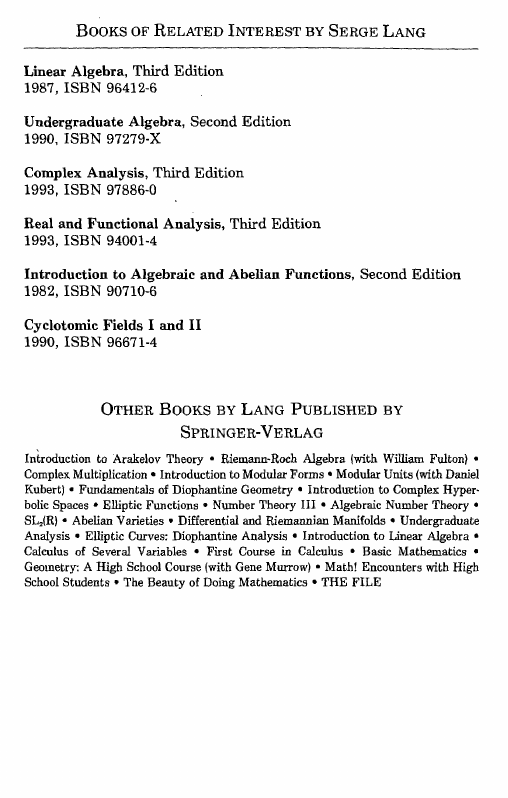

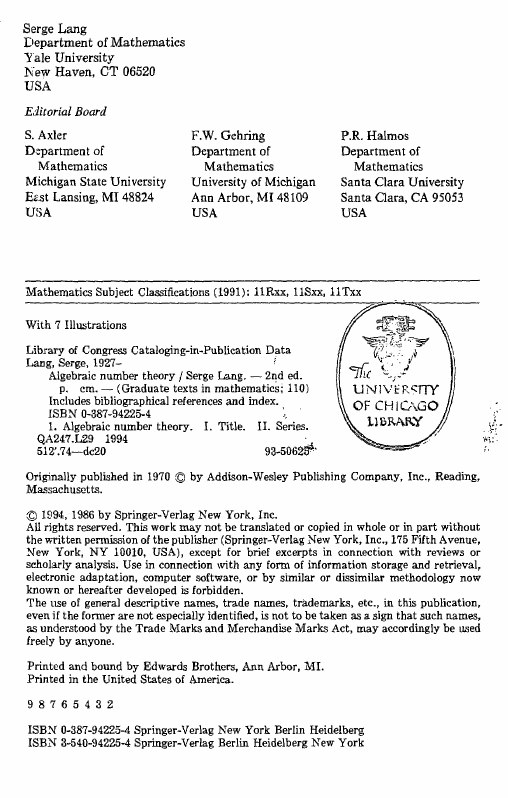
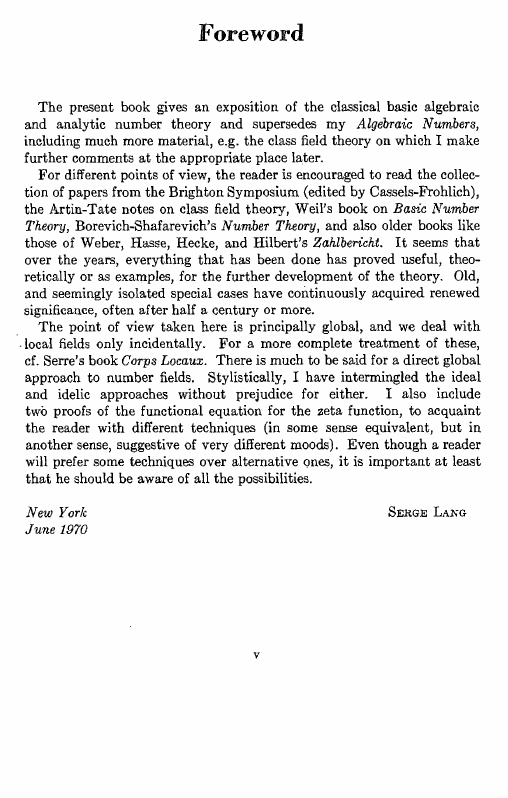
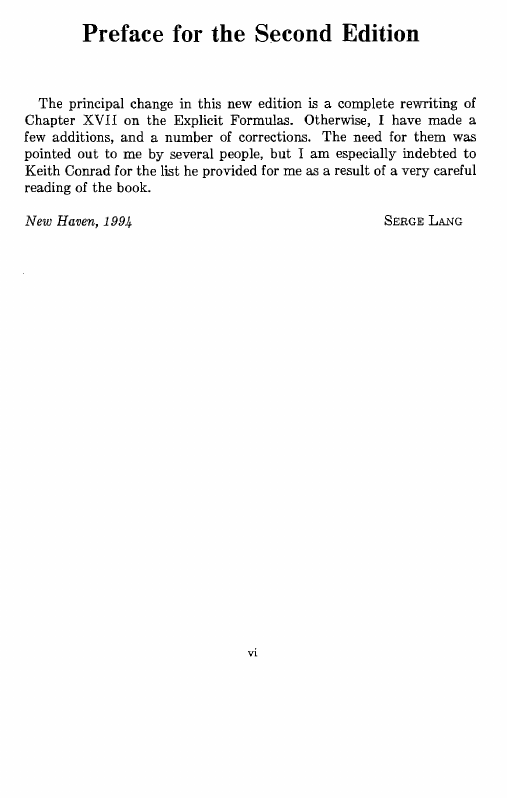
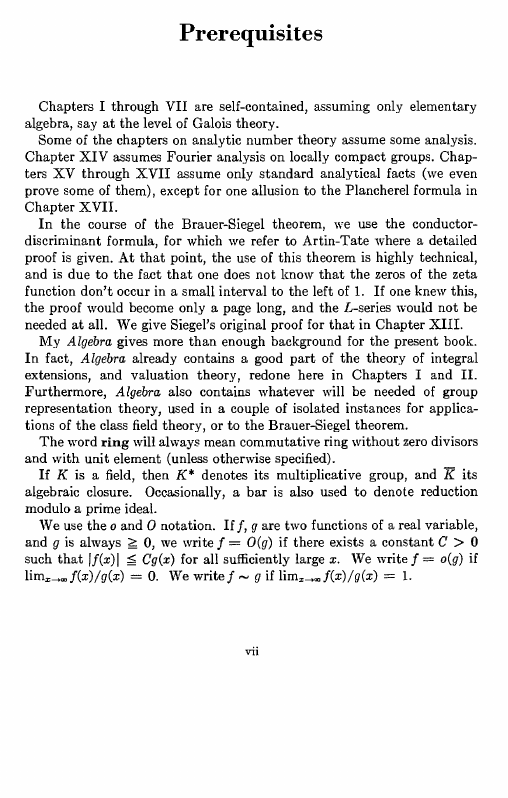

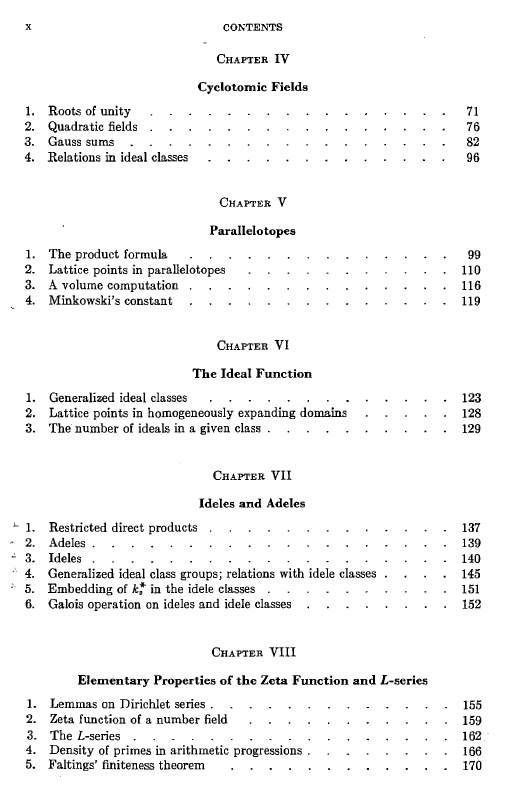








 2023年江西萍乡中考道德与法治真题及答案.doc
2023年江西萍乡中考道德与法治真题及答案.doc 2012年重庆南川中考生物真题及答案.doc
2012年重庆南川中考生物真题及答案.doc 2013年江西师范大学地理学综合及文艺理论基础考研真题.doc
2013年江西师范大学地理学综合及文艺理论基础考研真题.doc 2020年四川甘孜小升初语文真题及答案I卷.doc
2020年四川甘孜小升初语文真题及答案I卷.doc 2020年注册岩土工程师专业基础考试真题及答案.doc
2020年注册岩土工程师专业基础考试真题及答案.doc 2023-2024学年福建省厦门市九年级上学期数学月考试题及答案.doc
2023-2024学年福建省厦门市九年级上学期数学月考试题及答案.doc 2021-2022学年辽宁省沈阳市大东区九年级上学期语文期末试题及答案.doc
2021-2022学年辽宁省沈阳市大东区九年级上学期语文期末试题及答案.doc 2022-2023学年北京东城区初三第一学期物理期末试卷及答案.doc
2022-2023学年北京东城区初三第一学期物理期末试卷及答案.doc 2018上半年江西教师资格初中地理学科知识与教学能力真题及答案.doc
2018上半年江西教师资格初中地理学科知识与教学能力真题及答案.doc 2012年河北国家公务员申论考试真题及答案-省级.doc
2012年河北国家公务员申论考试真题及答案-省级.doc 2020-2021学年江苏省扬州市江都区邵樊片九年级上学期数学第一次质量检测试题及答案.doc
2020-2021学年江苏省扬州市江都区邵樊片九年级上学期数学第一次质量检测试题及答案.doc 2022下半年黑龙江教师资格证中学综合素质真题及答案.doc
2022下半年黑龙江教师资格证中学综合素质真题及答案.doc